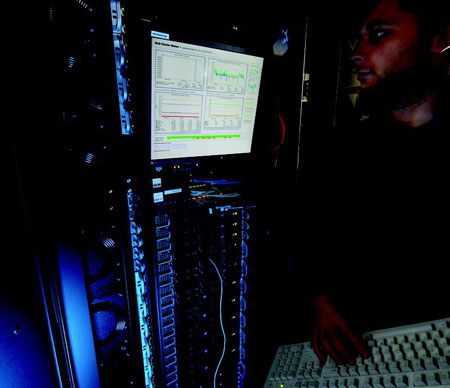| Dec 16, 2010 |
High-performance computer for simulating laser processes in nanophotonics
|
|
(Nanowerk News) Computer simulations play an essential role in research and development work. They provide a detailed insight into processes from which answers to specific questions can be derived. The simulation of laser-based production processes has to cover a wide span of time and length scales, especially in new techniques from micro- and nanophotonics. This requires special algorithms which have already been used successfully at the Fraunhofer Institute for Laser Technology ILT, as well as a massive amount of computer power. Fraunhofer ILT has built a high-performance computer cluster at the Center for Nanophotonics.
|
|
In laser-based production operations, important process variables are difficult to measure in the micrometer-scale process zones owing to the tiny dimensions and very high temperatures that prevail. Computer simulations are therefore being increasingly used to optimize performance. They provide an insight into the processes and are easier to automate and often more cost-effective than experiments. What's more, simulations enable fluctuations and measurement uncertainties to be excluded or specifically taken into account.
|
 |
| High-performance computer in the Center for Nanophotonics.
|
|
Multiscales – no problem for the computer cluster
|
|
Simulations of laser-based production processes tend to be multi-scale problems, in which a large expansion of the component has to be calculated at a very high resolution. Micro processing requires a resolution of a few nanometers and a calculation area with an expansion of several millimeters. For example, when processing thin-film solar cells, structures must be ablated extremely precisely and evenly from the layers which are just a few 100 nanometers thick.
|
|
Nano for macro
|
|
But in macro processing too, e.g. steel plate cutting, it is becoming increasingly important to be able to control small-scale effects in order to expand the process limits. To optimize expulsion of the molten metal during laser cutting, for instance, boundary layer phenomena of ultrasonic gas flows in the kerf are analyzed in detail.
|
|
High computer power in the Center for Nanophotonics
|
|
The required large number of grid points exceeds the capacity of conventional workstations in terms of processing time and storage space. The funding provided by the state of North Rhine-Westphalia for the new »Center for Nanophotonics« in Aachen has made it possible to create a high-performance computer cluster for simulations of these multi-scale tasks at Fraunhofer ILT. The final stage of the high-power computer system was installed and started up in November. In developing the concept, the research scientists in Aachen deployed a heterogeneous computer architecture consisting of multi-core processors and special high-performance computers with CUDA architecture, which allows parts of the calculations to be performed on graphics processors (GPUs). This modern concept is particularly suitable for the massively parallel execution of frequently recurring calculation steps. The installed cluster system has 376 CPUs and eight graphics processor systems with altogether 1920 GPUs. The storage capacity amounts to close on 2 terabytes of main memory and 67 terabytes of hard disk storage, of which 20 terabytes are on redundant interconnected drives. Data is exchanged within the cluster by means of a fast InfiniBand network. The theoretical total computer power is close on 10 teraflops, which roughly corresponds to the power of 1,000 modern office PCs. »The system is available to us around the clock on an exclusive basis. This means that simulations can be performed specifically for laser processes, to further our research and on behalf of customers, without any long waiting times. This makes our work much easier while also saving time and money,« explains Dr. Jens Schüttler, project manager at Fraunhofer ILT.
|
|
Applications
|
|
The new high-performance computer system can be used to simulate complex operations from laser material processing at high resolution in a short processing time. Applications include molecular dynamic simulation of ablation with ultra-short pulses, the configuration of micro processing techniques and the design of gas flows and gas-cutting nozzles. The propagation of laser radiation at wavelength scale and the stability of the melting dynamics in laser cutting can also be simulated. This range of applications is interesting for manufacturers and users of laser processing machines who want to analyze, optimize and improve their processes.
|

